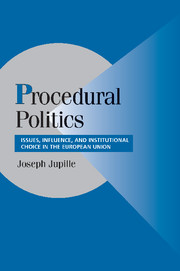Book contents
- Frontmatter
- Contents
- List of Figures
- List of Tables
- Preface and Acknowledgments
- List of Acronyms Used in the Text
- 1 INTRODUCTION: CHOICE, CONSTRAINT, AND EUROPEAN UNION INSTITUTIONS
- 2 THEORIZING PROCEDURAL POLITICS: ISSUES, INFLUENCE, AND INSTITUTIONAL CHOICE
- 3 THE EUROPEAN UNION AS A PROCEDURAL SYSTEM: RULES, PREFERENCES, AND STRATEGIC INTERACTION
- 4 PATTERNS: DETERMINANTS AND EFFECTS OF EU PROCEDURAL POLITICS
- 5 GREENING THE MARKET? PROCEDURAL POLITICS AND EU ENVIRONMENTAL POLICY
- 6 MAD COWS AND ENGLISHMEN: PROCEDURAL POLITICS AND EU AGRICULTURAL POLICY
- 7 CONCLUSION: PROCEDURAL POLITICS AND RULE GOVERNANCE IN THE EUROPEAN UNION AND BEYOND
- Bibliography
- Index
- Cambridge Cultural Social Studies
1 - INTRODUCTION: CHOICE, CONSTRAINT, AND EUROPEAN UNION INSTITUTIONS
Published online by Cambridge University Press: 24 July 2009
- Frontmatter
- Contents
- List of Figures
- List of Tables
- Preface and Acknowledgments
- List of Acronyms Used in the Text
- 1 INTRODUCTION: CHOICE, CONSTRAINT, AND EUROPEAN UNION INSTITUTIONS
- 2 THEORIZING PROCEDURAL POLITICS: ISSUES, INFLUENCE, AND INSTITUTIONAL CHOICE
- 3 THE EUROPEAN UNION AS A PROCEDURAL SYSTEM: RULES, PREFERENCES, AND STRATEGIC INTERACTION
- 4 PATTERNS: DETERMINANTS AND EFFECTS OF EU PROCEDURAL POLITICS
- 5 GREENING THE MARKET? PROCEDURAL POLITICS AND EU ENVIRONMENTAL POLICY
- 6 MAD COWS AND ENGLISHMEN: PROCEDURAL POLITICS AND EU AGRICULTURAL POLICY
- 7 CONCLUSION: PROCEDURAL POLITICS AND RULE GOVERNANCE IN THE EUROPEAN UNION AND BEYOND
- Bibliography
- Index
- Cambridge Cultural Social Studies
Summary
Procedure hasn't simply become more important than substance – it has, through a strange alchemy, become the substance of our deliberations. Who rules House procedures rules the House.
– Robert H. Michel, R-Ill.This is a book about “procedural politics,” the everyday conduct of politics not within, but with respect to, political institutions. The questions it asks are fundamental to political science, and indeed to “institutional” approaches across the social sciences: why, when, how, and with what effects do actors attempt to influence their institutional environment? Why, when, how, and with what effects, by contrast, do rules constrain them? The book develops and tests answers to these questions in the context of EU politics. The results of this inquiry paint a novel picture of EU politics and policymaking, suggesting most importantly (but somewhat paradoxically) that the EU exhibits a more profound degree of rule governance than is usually recognized. But these results generalize far beyond the EU, not only to other international organizations, but also to domestic political systems and, indeed, to all institutionalized political and social systems.
My general argument can be succinctly summarized. I assume that actors seek to ensure the usage of institutions (rules) that maximize their political influence. They are constrained, however, by the strategic nature of institutional choice – the need to interact with others – and by the availability of institutional alternatives.
- Type
- Chapter
- Information
- Procedural PoliticsIssues, Influence, and Institutional Choice in the European Union, pp. 1 - 14Publisher: Cambridge University PressPrint publication year: 2004



